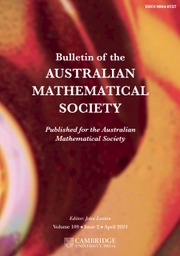No CrossRef data available.
Article contents
Hitting probabilities of conditional Brownian motion and polarisation
Published online by Cambridge University Press: 17 April 2009
Extract
Core share and HTML view are not available for this content. However, as you have access to this content, a full PDF is available via the ‘Save PDF’ action button.
We study the behaviour of the hitting probabilities of conditional Brownian motion in a domain D in Euclidean space when we apply polarization to D. We also study how polarization affects the probability that conditional Brownian motion meets a subset of D.
- Type
- Research Article
- Information
- Bulletin of the Australian Mathematical Society , Volume 66 , Issue 2 , October 2002 , pp. 233 - 244
- Copyright
- Copyright © Australian Mathematical Society 2002
References
[1]Baernstein, A. II, ‘Integral means, univalent functions and circular symmetrization’, Acta Math. 133 (1974), 139–169.Google Scholar
[2]Baernstein, A. II and Taylor, B.A., ‘Spherical rearrangements, subharmonic functions, and *-functions in n-space’, Duke Math. J. 43 (1976), 245–268.Google Scholar
[3]Banuelos, R. and Carroll, T., ‘Conditioned Brownian motion and hyperbolic geodesics in simply connected domains’, Michigan Math. J. 40 (1993), 321–332.CrossRefGoogle Scholar
[4]Banuelos, R. and Carroll, T., ‘Extremal problems for conditioned Brownian motion and the hyperbolic metric’, Ann. Inst. Fourier (Grenoble) 50 (2000), 1507–1532.CrossRefGoogle Scholar
[5]Banuelos, R. and Houswarth, E., ‘An isoperimetric-type inequality for integrals of Green's functions’, Michigan Math. J. 42 (1995), 603–611.Google Scholar
[6]Betsakos, D., ‘Polarization, conformal invariants and Brownian motion’, Ann. Acad. Sci. Fenn. Ser.A I Math. 23 (1998), 59–82.Google Scholar
[7]Brock, F. and Solynin, A. Yu., ‘An approach to symmetrization via polarization’, Trans. Amer. Math. Soc. 352 (2000), 1759–1796.Google Scholar
[8]Doob, J.L., ‘Conditional Brownian motion and the boundary limits of harmonic functions’, Bull. Soc. Math. France 85 (1957), 431–458.CrossRefGoogle Scholar
[9]Doob, J.L., Classical potential theory and its probabilistic couterpart, Fundamental Principles of Mathematical Sciences 262 (Springer-Verlag, New York, 1984).CrossRefGoogle Scholar
[10]Dubinin, V.N., ‘Capacities and geometric transformations of subsets in n-space’, Geom. Funct. Anal. 3 (1993), 342–369.Google Scholar
[11]Dubinin, V.N., ‘Symmetrization in the geometric theory of functions of a complex variable’, Russian Math. Surveys 49 (1994), 1–79.Google Scholar
[12]Griffin, P.S., McConnell, T.R. and Verchota, G.C., ‘Conditioned Brownian motion in simply connected planar domains’, Ann. Inst. H. Poincaré Probab. Statist. 29 (1993), 229–249.Google Scholar
[13]Kawohl, B. and Sweers, G., ‘Among all 2-dimensional convex domains the disk is not optional for the lifetime of a conditioned Brownian motion’, J. Analyse Math. (to appear).Google Scholar
[14]Nevanlinna, R., Analytic functions, (first edition in German 1936) (Springer-Verlag, New York, 1970).Google Scholar
[15]Solynin, A. Yu., ‘Functional inequalities via polarization’, (in Russian), Algebra i Analiz 8 (1996), 148–185; English translation in St.Petersburg Math. J. 8 (1997), 1015–1038.Google Scholar
[16]Wolontis, V., ‘Properties of conformal invariants’, Amer. J. Math. 74 (1952), 587–606.Google Scholar


